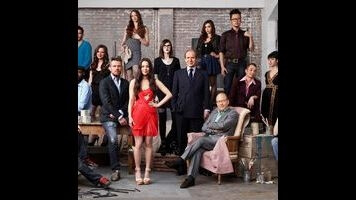Work Of Art: The Next Great Artist: "The Shape of Things to Come"

Even more than Project Runway and Top Chef, Bravo’s latest “Can this dude make a thing better than that other dude?” reality competition series Work Of Art is less about what it’s like to be a professional creative person than it is about what it’s like to be a student. Watching the first episode last week, I was reminded frequently of Dan Clowes’ comic book story “Art School Confidential” (later made into a not-so-good movie), especially when gazing upon that clown-trapped-in-a-palette monstrosity, and when hearing the art-estants defensively explain their work in front of the judges. I’ve enjoyed what I’ve seen of the show so far, but I worry a little that the artists who are good at advancing bold concepts and defending them eloquently might have an edge, not unlike college kids who know how to snow their professors and get top grades. And I don’t want this to be Top Bullshitter.
Tonight’s episode though showed that a significant amount of bullshit is pretty much inevitable when it comes to making, explaining, and evaluating art. In “The Shape Of Things To Come,” the artists were taken to a warehouse full of discarded electronics, given a speech about how there’s “something romantic and poetic about a found object” (which is true), and told to take these particular found objects and turn them into a sculpture that comments on our relationship to technology.
The artworks themselves were fairly strong, I thought—but then I’ve always liked gallery shows with moving parts. (Makes me feel like I’m 10 years old again and on a field trip to the local science museum.) What wasn’t so strong was all the jibber-jabber surrounding those artworks. Mark, for example, turned an old TV into a icon fit for a Day Of The Dead parade, all the while explaining that “TV has now replaced established religions in a way,” and how he was sure his work would be considered controversial because it had crosses painted on it. Uh-huh.
Even Nicole, who made one of the most interesting pieces when she filled a TV console with sedimentary layers of gadgetry, sounded like a tool when she explained what she was up to. (“So it, like, references American culture?”) And Judith tried to use words to cover up a total lack of inspiration, saying of her unstructured tangle of wires, “The old cords kind of took on a life of their own.” (Translation: “I got nothin’.”)
To be fair, the critics rightly trashed Judith’s work. They also, for the second week in a row, slammed a piece that was more design than art when they ripped apart Jamie Lynn’s “vacuum cleaner in kitschy painted backdrop” sculpture. But as Jamie Lynn herself pointed out, she’s not a sculptor, she’s a painter. And it’s hard to argue vis-a-vis Work Of Art—as I easily can with other reality competition shows—that the contestants ought to be more versatile. A chef should be able to cook anything, but who demands that an upper-echelon painter also know how to sculpt?
Then again, I find a lot of the usual reality-comp business bizarre in this art-world context—like the cockiness of some of the artists, and the dolled-up looks of some. On the flip side, Work Of Art is one of the few shows like this where the utter eccentricity of the participants seems less like an affectation. Artists are often weird and pretentious by nature, and though that makes them poor TV company at times, it also makes Work Of Art more interesting in some ways. The “reality” part of “reality competition” kicks in hard here. Will these oddballs be able stand each other?
